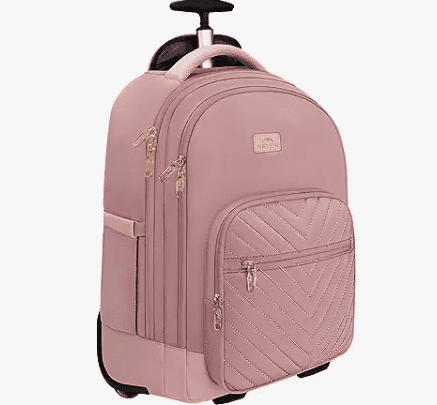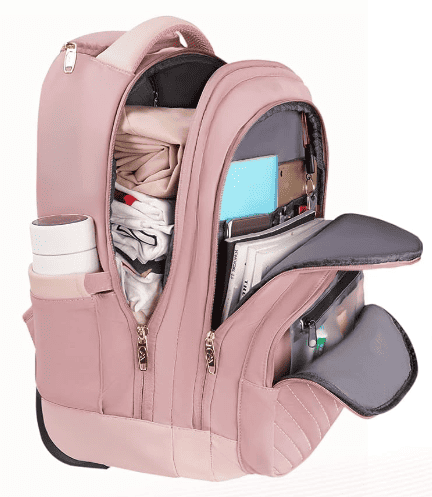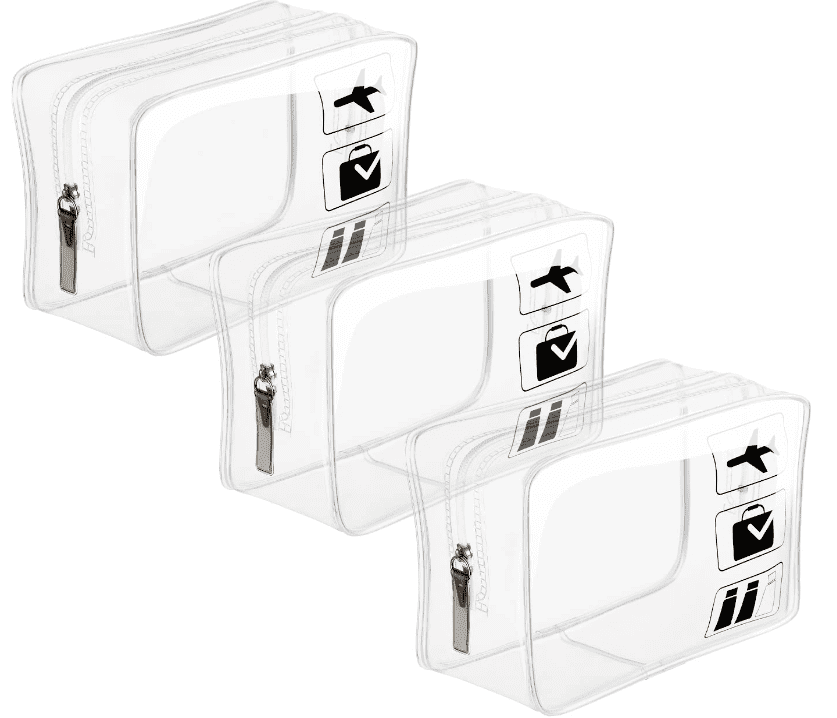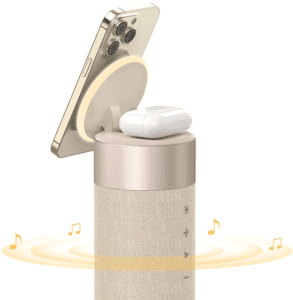Traveling can be both an exhilarating and exhausting experience, and the right carry-on backpack with wheels can make all the difference.
When preparing for a trip that entails moving through airports, navigating city streets, or traversing vast train stations, a wheeled backpack serves as a versatile travel companion.
It combines the portability of a backpack with the convenience of a rolling suitcase, allowing you to effortlessly switch between carrying it on your back and towing it behind you.
Selecting the perfect carry-on backpack with wheels requires evaluating several important features.
Durability, wheel quality, design, and organizational aspects all contribute to the overall functionality and ease of use.
While some travelers may prioritize ergonomic designs that reduce strain on the body, others might focus on the backpack’s capacity and the efficiency of its compartments.
Moreover, as travel needs vary, some may seek specialized models equipped and leave traditional backpacks for adventure-ready features or those that are produced with sustainability in mind.
Key Takeaways
- A wheeled carry-on backpack offers a blend of mobility and convenience for diverse kinds of travel.
- Essential attributes like wheel sturdiness, design, and compartment layout greatly affect backpacks’ usability.
- Selecting a backpack involves balancing comfort, specialized functions, and environmentally-conscious options.
Analyzing Carry-On Backpack Features
When selecting a carry-on backpack with wheels, pay close attention to its physical specifications, extra weight, extra features, and build quality to ensure it meets airline regulations and your travel needs.
Dimensions and Weight Standards
Your carry-on backpack must fit within airline size limits, typically not exceeding 22 x 14 x 9 inches.
Weight should not surpass 15 to 20 lbs to comply with most airline regulations otherwise it may not pass as a carry-on luggage and you might be forced to pay extra costs.
| Airline | Max Dimensions (inches) | Max Weight (lbs) |
|---|---|---|
| Air Canada | 22 x 14 x 9 | 15 |
| Emirates | 21 x 13 x 8 | 20 |
Evaluating Capacity and Volume
Your backpack’s capacity is crucial for determining how much you can carry.
Look for backpacks that offer 40 to 45 liters of volume, which is sufficient for most short trips(for international travel, you may want a check in luggage).
Compression straps can help manage the load, and zippered pockets along with internal organization features support easy access and efficient packing.
- Volume: 40-45L ideal for short trips
- Compression straps: For compact packing
- Internal organization: For easy access
Understanding Durability and Materials
For a robust backpack, prioritize materials such as high-denier nylon or polyester that are tear and abrasion-resistant. The inclusion of a laptop sleeve protects your electronics while traveling.
Water-resistant materials, like those found in the Tropicfeel Shell, protect against the elements. Check for a sturdy hip belt to distribute weight evenly when the backpack is detached from the wheels.
- Materials: High-denier nylon/polyester for tear resistance
- Laptop sleeve: For electronics protection
- Durability: Features like the Torticfeel Shell for enhanced endurance
The Best Wheels for Travel Backpacks
When considering a carry-on backpack with wheels, the quality of the wheels themselves is critical for seamless transit and reducing wear over time.
You want smooth-rolling wheels, adjustable shoulder straps and zippered top pocket possibly a lockable to keep your stuff safe.
Wheels and Maneuverability
Materials
: Your carry-on backpack’s wheels should be constructed from high-density polyurethane or similar rugged materials to resist abrasion and cracking.
Size: Larger wheels tend to navigate uneven surfaces more efficiently, making them a great choice for varied terrain.
Construction: Look for wheels with sealed ball bearings to ensure smoother rolling and enhanced durability.
- Wheels Placement: Optimal wheel placement should ensure stability and prevent your backpack from tipping over when fully loaded.
- Retractable Handle: A sturdy retractable handle, often made of aluminum, is essential for maneuvering your backpack with ease, pull handle makes travel bags easy to transport especially in large airports.
Backpacks vs. Rolling Suitcases
Functionality
: Carry-on backpacks with wheels offer the versatility of being carried on your back or rolled behind you, which is a significant advantage over traditional rolling suitcases in congested or uneven environments.
- Interior Space: Backpacks often have a soft structure that can adapt to irregularly shaped items better than a hard-sided rolling suitcase.
- Portability: Without the necessity for a completely rigid frame, wheeled luggage in the form of a backpack tends to be lighter and easier to lift into overhead bins or carry up stairs.
- Convenience: The option to switch between rolling and carrying your wheeled bag caters to a broader range of travel scenarios and personal preferences.
Design and Style Considerations
When selecting a carry-on backpack with wheels, the design and style reflect your personal taste and travel needs.
These considerations influence both how you look and how well the backpack serves you during your travel be it short or long-term travel.
Trendy Designs for Modern Travelers
Travel style has evolved, and manufacturers have responded with carry-on backpacks that are not only functional but also fashionable. You’ll find designs that embrace sleek lines and contemporary features.
For example, a front zippered pocket is a common characteristic that offers easy access to essentials like travel documents and electronics.
Moreover, a modern wheeled travel backpack may include seamless integration of charging ports or RFID-blocking compartments.
Trends highlight minimalistic designs with subtle color palettes or monochrome schemes that match professional and casual looks alike.
Backpack Aesthetics and Personal Style
Your backpack suitcase should be an extension of your personal style. As such, you’ll appreciate that carry-on backpacks with wheels come in a wide range of colors, patterns and different sizes, allowing you to choose one that best suits your aesthetic preferences.
Whether you prefer a bold red to stand out in the crowd or a classic black for a more sophisticated look, there’s a plethora of options.
When considering aesthetics, pay attention to the material finishes such as matte, glossy, or textured surfaces, each contributing to the backpack’s overall vibe.
Your choice in design can also enhance functionality—bag shapes can range from laid-back, sporty models to those that convey a sharper, business-ready appearance.
Organizational Features of Backpacks
When selecting a carry-on backpack with wheels, the layout and design of its compartments dictate how conveniently and efficiently you can pack your essentials.
Tech-Friendly Compartments
Your carry-on backpack should feature a laptop sleeve — ideally padded — to protect your electronics during travel.
Companies like Osprey and Cotopaxi offer designs where these sleeves are easily accessible, ensuring your devices are both secure and reachable.
Look for additional features like compression straps to stabilize your gadgets and zippered mesh compartments for organizing your cables and chargers.
- Laptop Sleeve: Ensure it’s padded for the maximum safety of your device.
- Zippered Mesh Compartment: Ideal for separating small tech accessories.
Clothing and Accessories Storage
Organize your clothing efficiently using packing cubes that fit neatly into the main compartment.
A zippered mesh compartment can serve as a separator for your accessories or dirty laundry.
Some backpacks feature design elements that expand, giving you more space for your clothing, while the compression straps help to reduce the bulkiness and maintain the compact shape of the backpack.
- Packing Cubes: Utilize these for systematic clothing arrangement.
- Compression Straps: These aid in maintaining the backpack’s shape and making extra room.
Comparison of Top Backpack Brands
When you consider purchasing a carry-on backpack with wheels, the most important factor is to look at what each brand offers in terms of design, water resistance, durability, and functionality.
Osprey’s Travel Backpack Options
Osprey is renowned for its ergonomic design and the robust quality of their travel backpacks. Your attention may be drawn to the Osprey Meridian which boasts integrated wheels and a high-clearance retractable handle, making it a comfortable carry and easy to pull.
The backpack straps can also tuck away, providing versatility when you transition from airport to city streets.
I`m not trying to be biased here but to me, Osprey ranks quite high when comparing the best travel backpacks.
Innovations by Cotopaxi and Samsonite
is a distinguished choice featuring weight distribution and innovative storage capabilities, with a unique, colorful design to easily spot on the luggage carousel.
The Allpa 35L does not have wheels, but its versatility and comfort make it a favorite for those who prefer a multi-functional backpack.
So although it might not be the best wheeled backpack, it still ranks quite high in our books.
Samsonite, on the other hand, provides the Silhouette 17 Backpack which combines the convenience of wheeled luggage with the ease of a backpack.
It’s designed to satisfy the needs of a modern traveler with thoughtful compartments and sturdy wheels suitable for various terrains, it`s suitable for short business trips.
Your travel needs and personal style will guide your decision. Osprey provides a durable, tried-and-tested product suitable for rugged environments, while Cotopaxi offers a creative and adaptable solution.
Samsonite merges tradition and innovation for an all-around travel experience. Each brand has its merits, ensuring you can choose the best rolling backpacks that aligns with your travel demands.
Special Features for Adventure Travel
When selecting a carry-on backpack with wheels for adventure travel, choose a model robust enough to handle rugged terrain, is water resistant, and has enough storage space while providing easy mobility and protection for your gear.
Backpacks Built for the Outdoors
Your ideal outdoor companion, a backpack with wheels designed for adventure travel, should have all-terrain wheels and a retractable handle.
Look for heavy-duty fabrics such as rip-stop nylon, which resists tears and abrasions.
For structure and comfort against your back, seek out models with a padded back panel, spacious main compartment and ergonomically designed shoulder straps that can be stowed when not in use.
- Materials: Rip-stop nylon, water-resistant coatings
- Comfort Features: Padded straps, ventilated back panels
- Structure: Stowable straps, durable wheel housing
Advanced Features for Backpackers
For those who venture further into the wilderness, your carry-on backpack with wheels should transform seamlessly into a duffel bag for when the terrain becomes too challenging for wheels. Critically, a detachable rain cover can safeguard your belongings from the elements.
Organizational features like compression straps, multiple access points, and lockable zippers will keep your travel gear secure and accessible.
- Transformation: Wheels-to-duffel capability fro longer trips
- Protection: Detachable rain cover, lockable zippers
- Organization: Compression straps, multi-compartment design
A backpack with these specialized features ensures that your adventure travel is equipped with versatility and readiness for the outdoors.
You may like
Is a backpack considered a carry on
The best luggage for teenage girls
Comfort and Ergonomics
When selecting a carry-on backpack with wheels, your comfort and the bag’s ergonomics can have a significant impact on your travel experience.
Features like adjustable straps and sufficient padding are essential for managing the backpack’s fit and weight distribution.
Adjustable Straps and Padding
Your carry-on backpack should have adjustable straps to tailor the fit to your body. Look for padded shoulder straps that can be easily tightened or loosened.
This customization allows you to position the backpack to align properly with your center of gravity, reducing strain on your back and shoulders.
Additionally, a padded laptop sleeve will not only protect your device but also cushion your back against hard edges.
- Shoulder Straps: Ensure they are wide and padded.
- Hip Belt: Distributes weight away from the shoulders.
- Sternum Strap: Adds stability, particularly when on the move.
Backpack Fit and Load Distribution
To maintain comfort, especially during extended periods of wear, your backpack should distribute weight evenly.
A proper fit prevents the bag from shifting and maintains balance whether you’re wearing the backpack or wheeling it.
An adjustable and padded hip belt is crucial, as it transfers a significant amount of the load from your shoulders to your hips.
Equally important is an adjustable sternum strap which helps to stabilize the load and distributes weight more evenly across the chest.
- Weight Balance: Equal distribution between shoulders and hips.
- Stability: Prevents shifting that can cause discomfort and fatigue.
By carefully considering the comfort and ergonomics of your carry-on backpack with wheels, you can ensure a more enjoyable and less strenuous travel experience.
Specialty Backpacks and Their Uses
Specialty backpacks are designed to cater to the specific needs of various users.
Whether you’re a hiker, a digital nomad, a student, or a professional heading to the office, each category comes with features that help you manage your load efficiently.
Backpacks for Hikers and Digital Nomads
When selecting a backpack for hiking or as a digital nomad, you’re looking for durability, ergonomic support, and smart space allocation.
Hikers require backpacks with integrated frames, waist straps for weight distribution, and compartments for hydration systems. Look for materials such as rip-stop nylon that withstand rough terrain and changing weather.
For digital nomads, prioritize backpacks with padded laptop compartments, hidden pockets for valuable items, and USB ports for on-the-go charging.
- Key features for hikers:
- Water-resistant material (e.g., rip-stop nylon)
- Frame support and waist straps
- Hydration system compartments
- Key features for digital nomads:
- Padded laptop compartment
- Hidden pockets for security
- Built-in USB ports
Choosing a Backpack for School or Office
For school backpack use, select a backpack with wheel functionality, heavy on compartmentalization, to organize textbooks, devices, and stationery.
Look for sturdy construction and adjustable straps to ensure the backpack lasts the school year.
Opt for backpacks with reflective strips for kids to enhance their visibility when traveling to and from school.
If you’re heading to the office, choose a sleek design that aligns with a professional setting. Essential features include a padded compartment for your laptop or tablet, an organized panel for documents, and a trolley sleeve to attach to rolling luggage for commuting ease.
- Key features for school:
- Multiple compartments for books and supplies
- Durable construction with adjustable straps
- Reflective strips for safety (especially for kids)
- Key features for office:
- Padded laptop/tablet compartment
- Organizational panel for documents
- Trolley sleeve for easy attachment to rolling luggage
Accessories and Complementary Gear
Selecting the right accessories can significantly enhance the convenience and efficiency of your carry-on backpack with wheels. Focusing on practicality and ease of use will ensure a smoother travel experience.
Must-Have Travel Accessories
- Packing Cubes: Utilize packing cubes to organize and compress your clothes, optimizing space within your backpack. They make unpacking and locating specific items effortless, keeping your belongings tidy throughout your journey.
Packing Cube Size Suggested Use Small Electronics, chargers Medium Shirts, shorts Large Pants, jackets - Padded Compartment: A separate, cushioned compartment is essential to protect your electronics. It isolates devices such as laptops and tablets from potential damage during travel.

Enhancing Backpack Functionality
- Travel Gear: Ensure your backpack has easily accessible pockets for storing essential travel gear. Look for features such as a water bottle holder, a hidden passport pocket, or a quick-access top pocket for items like tickets and snacks.
- Straps and Handles: Adjustable padded shoulder straps and a robust telescoping handle add versatility. Whether you’re rolling your bag through the airport or carrying it up a flight of stairs, these features can provide comfort and convenience.
Remember, carefully chosen accessories aimed at increasing organization and protecting your valuables can make your carry-on backpack with wheels a steadfast travel companion.
Assessing Value and Budget Options
When selecting the best carry-on backpack with wheels, your priority should be finding a product that represents the best value for money without compromising on quality.
Within a budget-friendly range, there are options that boast features typically found in higher-end models.
Finding a Balance Between Cost and Quality
In the quest for value, the interplay between affordability and durability is paramount. A high-quality carry-on backpack with wheels doesn’t necessarily have to drain your wallet.
Look for models that are made of robust materials, such as ripstop nylon or polyester, which are budget-friendly yet resistant to wear and tear.
Additionally, check for user reviews and warranty periods as indicators of the product’s longevity.
For instance, the Victorinox range often provides a generous warranty, reflecting the brand’s confidence in its product’s durability.
| Price Range | Material Quality | Warranty | User Ratings |
|---|---|---|---|
| $50-$100 | Medium | Varies | 3.5-4 stars |
| $101-$150 | High | 1-5 years | 4-5 stars |
| $151-$200 | Premium | 2-10 years | 4.5-5 stars |
Budget-Friendly Backpacks with Premium Features
Your budget doesn’t have to limit you to basic features. Some affordable carry-on backpacks come with added bonuses like integrated USB ports, lockable zippers, and expandable compartments.
When considering budget options, keep an eye out for seasonal sales or discounts, which can bring a usually pricier Victorinox backpack into the realm of affordability, making it an ideal gift or a smart purchase for your travels. Products in the $50-$200 range can still offer features such as:
- Organization: Multiple compartments for laptops, documents, and clothing.
- Mobility: Telescopic handles and sturdy wheels.
- Comfort: Padded straps for when you prefer to carry your bag.
By focusing your search on essential features rather than luxury add-ons, you can find a carry-on backpack that meets your travel needs and remains within your budget.
Sustainable and Ethical Choices
When selecting a carry-on backpack with wheels, your decision can extend beyond practicality.
Choosing brands and products with a commitment to sustainability and ethics ensures that your travel gear aligns with values that support the environment and fair labor practices.
Eco-Friendly Materials and Practices
In your quest for a sustainable carry-on, pay special attention to backpacks using eco-friendly materials. Look for options that utilize recycled plastics or responsibly sourced organic materials that minimize environmental impact.
Water-repellent finishes are common in travel gear; ensure that the one on your backpack is non-toxic and PFC-free.
Also, examine the hardware quality, like YKK zippers, which are known for their durability—reducing the need for frequent replacements and thereby lowering waste.
- Materials: Recycled PET, organic cotton, or hemp
- Finishes: PFC-free water-repellent coating
Supporting B-Corp Certified Brands
Supporting B-Corp-certified companies means you are choosing brands that meet stringent standards of social and environmental performance, accountability, and transparency. Backpacks from these companies often double as duffel bags, providing versatility while maintaining ethical production standards.
When you invest in a product from a B-Corp, you’re not just buying a piece of luggage; you’re contributing to sustainable travel and a better business ecosystem.
- Certification: Look for the B-Corp logo
- Design: Convertible backpacks that serve dual purposes (e.g., backpack and duffel bag)
By making informed choices, you can ensure that your travel gear reflects both your needs and your commitment to a more ethical and sustainable world.
Frequently Asked Questions
When selecting a wheeled backpack, consider your specific needs such as size, comfort, and functionality. Here are some common queries to help you find the perfect wheeled backpack.
Which backpacks with wheels are suitable for girls?
For girls, the J World New York Sunrise Rolling Backpack offers bright designs and is compact enough for easy handling. It combines durability with a lightweight structure, ideal for everyday use.
What are the top lightweight rolling backpacks for school use?
The High Sierra Freewheel Wheeled Laptop Backpack is optimal for school, featuring a padded laptop sleeve and multiple compartments while being light enough to carry without strain.
Which is the best carry-on luggage with a detachable backpack?
The Osprey Meridian is revered as a top-tier carry-on with a detachable daypack, providing versatility and convenience for short trips and organized travel.
What are the most spacious rolling backpacks suitable for adults?
Spacious options for adults include the Samsonite Wheeled Backpack, which offers extensive compartments for organization and is built to endure the rigors of daily use.
Which wheeled backpack is recommended for traveling in Europe?
The Eagle Creek Gear Warrior is a favored choice for European travel, with its rugged design, ample space, and adherence to carry-on size restrictions of most airlines.
How does a rolling backpack compare to a regular backpack in terms of convenience for travel?
A rolling backpack alleviates the burden on your back and is easier to maneuver in airports and urban settings, yet it retains the flexibility to be carried like a traditional backpack when needed.




